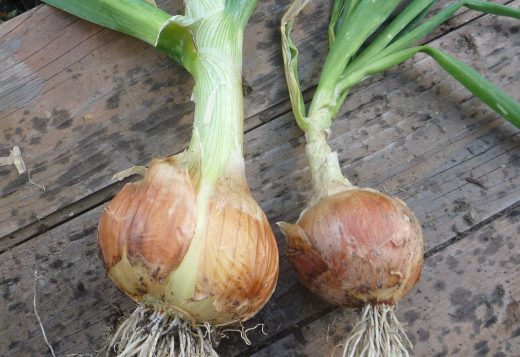HOW TO RECOGNISE ONION NECK ROT
The damage will almost certainly not be visible until the onions have been in storage for a couple of weeks. At first the top part of the bulb will turn browner and the skin will be darker brown. If you gently push the top of the bulb at this stage it will be softer than the lower parts.
Mould will then appear which is grey, sometimes speckled with small black spots, and the bulbs will deteriorate even further. If the onions are in a confined space the air will smell musty.
LIFE CYCLE OF ONION NECK ROT
The entire life cycle of this disease is probably irrelevant for the amateur gardener because where onions are grown the spores of this disease will be invisibly present and that’s just a fact of growing onions. When the spores settle on the surface of an onion they can infect it either where there is damage to the surface or through the fleshy part of the neck of the bulb.
At this stage nothing is visible to the naked eye but the fungus will multiply and within four to eight weeks the onion will start to become significantly damaged. Spores (technically sclerotia) overwinter in the soil and can live for up to two years there.
TREATMENT OF THE ONION NECK ROT
There is no chemical or biological control of neck rot available to the amateur gardener, prevention is the only mechanism for avoiding this disease.
PREVENTING ONION NECK ROT
The key points to avoiding neck rot or at least minimising the damage done are:
- Avoid damaging onion bulbs at any time but especially near or during harvest.
- Don’t bend over foliage to hasten drying out, that simply provides an ideal entry point for the spores.
- Only harvest onions when the necks have ripened and fallen over of their own accord.
- Avoid using high nitrogen fertilisers especially from July onwards. Nitrogen fertilisers encourage lush green growth which make ideal conditions for this disease.
- Always buy seeds and sets from trusted suppliers. You may pay a little more but its worth the money.
- Don’t plant onions bought from shops / supermarkets, they are not intended for growing on and have a high chance of already being infected.
- Use a three or four year crop rotation system.
- Dry the bulbs out thoroughly at harvest time. Two or three dry, sunny days with the bulbs placed on their sides on dry ground is best.
- If rain threatens, place the bulbs under cover (a dry shed, garage or greenhouse) with lost of ventilation. Good ventilation is more important in the drying process than sun.
- Store only bulbs with dried out thin necks, others should be used as soon as possible. Consider freezing some if they are not in ideal condition, onions freeze well if correctly prepared. The picture below shows an onion on the left with a thick neck which will not store well. The thin-necked onion on the right will store far better.
- Store bulbs in a cool and dry place which has good air circulation. Throw out or use any which show signs of rot.

![]()
Thick and thin onion necks
Other common pests and diseases which affect onions include:
IDENTIFY, PREVENT, TREAT ONION NECK ROT
By David Marks
Onion neck rot normally only becomes visible when onions are in storage but the infection occurs about four weeks before the rotting gets underway. The cause of the infection is a fungus called Botryitis aclada / allii which enters the onions through wounds or cracks in the fleshy neck part of the bulb.
This disease is one very good reason not to turn over the leaves of onions to quicken the drying out process.